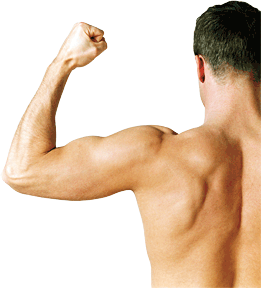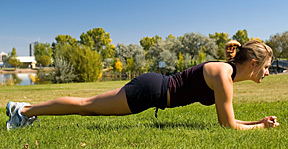A Cardio Workout That Can't Be Beat
By Chelsea Cooper, MPA, CPT
Considering how important the heart is in moment-to-moment and lifelong health, it's amazing how many people ignore it, assuming it will stay strong and vital on its own. That lack of concern probably accounts for the rising rates of cardiovascular disease, particularly here in the United States. Your heart needs you as much as you need it, and the best way to keep it strong is by making it work hard on a consistent basis. In short, exercise makes the heart stronger; here's a great workout to do just that.
The heart is said to be the source of one's being, emotions and sensibilities, according to Webster's Dictionary, but at its basic level, the heart is also a muscle. And just like the rest of the muscles in our body, the more you work the heart muscle, the stronger and more effective it becomes. The heart has an amazing ability to adapt to exercise. Everything gets bigger; the size of the chambers, the thickness of the walls, etc.
The heart sits to the left of the middle of your chest and is about the size of your fist. Although we have many muscles throughout our body, the heart is a special muscle because it sends the blood throughout the body. Blood provides oxygen and vital nutrients to the brain, body and extremities, and transports oxygen-poor blood from the brain and extremities to the lungs to get oxygen. Valves inside the heart open and close, which controls how much blood enters or leaves the heart.
As you can tell, it is of utmost importance that we take care of this major muscle. Unfortunately, in the United States heart attacks are the leading cause of death. The root of the cause is arteriosclerosis (say that three times fast) - accumulation of plaque or "curd" (cholesterol, fatty deposits and other substances), on the inner lining of artery walls, which causes blood flow to the heart to decrease, and could cause an eventual heart attack. This is mostly caused by poor nutrition and inactivity.
Exercise Is Great for the Heart
 Studies continue to show that physical activity and avoiding high-fat foods are the two most successful means of building and maintaining a healthy heart. Walking, jogging, jumping rope, bicycling, skating, dancing and water aerobics are just a few examples of aerobic exercises that will help keep your heart strong. When exercising, the heart's job is to get more blood out to your body's hard-working muscles. During exercise, blood flow (as indicated by the number of times the heart beats) increases by about four or five times that of its resting heart beat, depending on the exercise you're doing.
Studies continue to show that physical activity and avoiding high-fat foods are the two most successful means of building and maintaining a healthy heart. Walking, jogging, jumping rope, bicycling, skating, dancing and water aerobics are just a few examples of aerobic exercises that will help keep your heart strong. When exercising, the heart's job is to get more blood out to your body's hard-working muscles. During exercise, blood flow (as indicated by the number of times the heart beats) increases by about four or five times that of its resting heart beat, depending on the exercise you're doing.
A sedentary inactive lifestyle is one of the top risk factors for heart disease. The good news is that you can do something about it. Regular exercise has a number of effects that benefit the heart and circulation, including improving cholesterol and lipid levels, reducing inflammation in the arteries, and helping to keep blood vessels flexible and open.
To achieve maximum benefits, you should gradually work up to an aerobic session lasting 20 to 30 minutes at least three to four times a week. Exercising every other day will help you keep a regular aerobic exercise schedule. Aerobic exercise has the most benefits for your heart. Over time, it can help decrease your heart rate and blood pressure at rest, and improve your breathing. Resistance (weight) training has also been associated with heart protection. It may offer a complementary benefit to aerobics by reducing cholesterol (particularly "bad" cholesterol) levels.
Try This Heart-Pumping Workout
The following exercise routine should be done carefully and correctly. I've outlined the routine below, followed by descriptions of each exercise. This routine is designed to get your heart pumping and stronger, and all your muscles working. It only takes about 20 minutes to complete, including warm-up, but trust me, you'll feel it and your heart will feel it (in a good way)! Make sure to talk to your doctor before beginning any new exercise program, particularly if you have a pre-existing health condition or have any questions about how to properly perform any of the exercises/motions.
Warm-Up (30 seconds per exercise) - 4 minutes
- Jumping jacks
- Pushups
- Stick-ups
- Running in place
Perform the above exercises in order and then repeat the entire warm-up circuit (two times total).
Strength Circuit (30 seconds per exercise) - 3 minutes
- Vertical jumps
- Spiderman push-ups
Do both exercises for 30 seconds apiece; then rest for one minute and repeat.
Water Break - 1 minute
Intense Cardio Training - 10 minutes
-
 Body-weight squats - 20 seconds of body-weight squats followed by 10 seconds of walking/recovery. Repeat seven times (eight total rounds).
Body-weight squats - 20 seconds of body-weight squats followed by 10 seconds of walking/recovery. Repeat seven times (eight total rounds).
- Rest for two minutes and drink water after completing all eight rounds.
- Push-ups - 20 seconds of push-ups followed by 10 seconds of rest times eight rounds.
Total Body Ab Circuit (30 seconds per exercise) - 4 minutes
- Spiderman climbs
- Planks
- Mountain climbers
Rest 1 minute before repeating entire circuit one time.
Cooldown, stretching and water break - 5 minutes
How to Perform Each Exercise
Stick-Up
- Stand with your back against a wall. Your feet should be 6 inches away from the wall and your butt, upper back and head should all be in contact with the wall at all times. Raise your hands up over your head. Try to keep your shoulders, elbows, and wrists in contact with the wall at all times.
- Slide your arms down the wall and tuck your elbows into your sides. This should bring your shoulder blades down and together. You should feel a strong contraction in the muscles between your shoulder blades as well as the shoulder muscles. Maintain as much contact with the wall as possible.
- From the bottom position, try to slowly slide your arms up until they are straight and in a "stick-em up" position. Again, try to keep everything in contact with the wall.
- Do as many repetitions as possible in the allotted time.
Vertical Jump
- Stand in the start position for the body-weight squat.
- Squat down and jump up as high as possible.
- Bend your knees when you land to absorb the force with your muscles.
- As soon as you land, jump up again. Repeat for as many repetitions as possible in the allotted time.
Body-Weight Squat
- Stand with your feet just greater than shoulder-width apart.
- Start the movement at the hip joint. Push your hips backward and "sit back into a chair" (pretend you have a chair). Make your hips go back as far as possible.
- Squat as deep as possible, but keep your low back tensed in a neutral position.
- Don't let your lower back become rounded.
- Push with your glutes, hamstrings, and quadriceps to return to the start position.
- Do as many repetitions as possible in the allotted time.
Spiderman Push-Up
- Keep the abs braced and body in a straight line from toes (knees) to shoulders.
- Place the hands on the floor slightly wider than shoulder-width apart.
- Slowly lower yourself down until you are 2 inches off the ground.
- As you lower yourself, slowly bring your right knee up to your right elbow. Keep your foot off the ground as you do so.
- Push through your chest, shoulders and triceps to return to the start position, and return your leg to the start position.
- Keep your body in a straight line at all times and try not to rotate at your hips.
- Do as many repetitions as possible in the allotted time, switching the foot you elevate off the ground with each repetition.
Spiderman Climb
- Brace your abs. Start in the top of the push-up position.
- Keep your abs braced, pick one foot up off the floor, and slowly bring your knee up outside of your shoulder and touch your foot to the ground.
- Keep your abs braced and slowly return your leg to the start position.
- Alternate sides; do as many repetitions as possible in the allotted time.
 Plank
Plank
- Support your weight on your forearms and your toes.
- Keep your abs braced and breathe normally.
- Hold that position for the allotted time.
Mountain Climbers
- Brace your abs. Start in the top of the push-up position.
- Keep your abs braced, pick one foot up off the floor, and slowly bring your knee up to your chest. Do not let your hips sag or rotate.
- Keep your abs braced and slowly return your leg to the start position.
- Alternate sides; do as many repetitions as possible in the allotted time.
Now that you know how vital the heart is and what you can do to keep it healthy and working properly, it's time to start today! Protect your heart by doing exercise at least three to four times a week for 20 to 30 minutes. No matter which exercises you choose, remember to drink enough water before, during and after to prevent dehydration. Finally, use your good judgment and stay within your exercise limits. Light exercise performed regularly is always better than one gut-wrenching workout session a week. Your body will tell you if you are pushing it too hard. Also be conscious of your eating habits and choices. Your heart matters, so take of it and it will take care of you for years to come. Talk to your doctor for more information.
Chelsea Cooper, MPA, CPT, is certified by the National Academy of Sports Medicine as a personal trainer, performance enhancement specialist, and rehab and exercise specialist. To learn more, visit www.trainwithchelsea.com.
Page printed from:
http://www.toyourhealth.com/mpacms/tyh/article.php?id=1334&pagenumber=3&no_paginate=true&no_b=true
|

